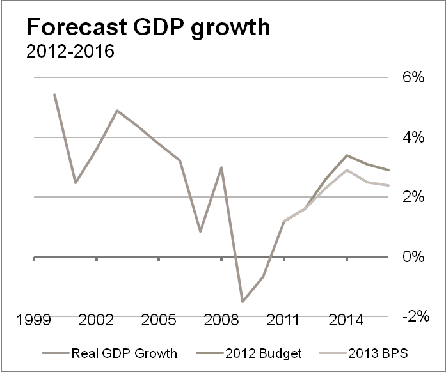Looking forward to a classic “middle child” Budget
Tuesday 18 December 2012
Commentary
Looking forward to a classic “middle child”
Budget:
five minutes on the 2013 Budget Policy Statement
and Half Yearly Economic and Fiscal Update
The Minister of Finance and the Treasury released two key documents that signal the direction the economy and Government will take over the next few years. The Budget Policy Statement (BPS) signals the Government’s strategic intentions for Budget 2013 and outlines the most important opportunities, constraints and challenges. The December Half Yearly Economic and Fiscal Update (HYEFU) lets us know how the Government finances and the economy in general are tracking.
Economic overview – Treasury revise to a much less bullish position
The Treasury have revised its economic growth forecasts downwards from an average of 3% growth per year to a 2.5% average for the next five years.

The revision is more in line with the position we took in Budget 2013. To achieve 3% average growth, we would have had to deliver an economic performance equivalent to that of the early 2000’s, where the New Zealand dollar was low and our commodity prices high.
There are certainly some stronger signs of an uplift in growth with some lift in our trading partners, and getting the ball rolling on the Christchurch rebuild. Yet, this has been offset by redundancies in the manufacturing sector, mixed commodity prices and a very high New Zealand dollar. The Treasury forecasts are much more in line with what we are seeing in the data and hearing from our clients.
The Government books – worse, and real concerns over debt
Compared to the 2012 Budget in May, the operating balance and debt forecasts have deteriorated. We find it surprising Treasury is still predicting a return to a surplus position in 2014/15, with a surplus of $66 million (down from $197 million at Budget). The Treasury are pinning its hopes on a continued reduction in Crown expense growth which it is forecasting to drop to around 30% of GDP as compared to almost 32% of GDP at Budget time.
We hold the view we took in Budget 2012 that this result is optimistic, especially given the downward revision in the economic forecasts. We feel the Treasury’s downside scenario of a return to surplus in 2016/17 is more realistic.
The net debt position is worse than what was forecast at Budget, peaking at 29.5% of GDP. What is the most concerning part of the forecasts is that net debt continues to remain around 29% of GDP, which is a significant change from Budget 2012 where it was forecast to go below 20% of GDP by 2020.
Looking ahead to the 2013 Budget – A classic “middle child”?
Year 2 Budgets are often best described as the "middle child" Budgets. Year 1 budgets are where all the tough stuff gets done, but they define the style of the Government. Year 3 budgets have all the attention and gifts. Often governments use middle Budgets to bank gains in preparation for year 3, and signal future intentions.
We see a great deal of the middle child treatment in store for 2013 with the BPS talking maintaining the Government’s plan with continued focus on previously signalled macroeconomic reform programmes, better value from public services and investments in infrastructure.
Our view remains the Government is working hard to maintain a responsible course between stimulus and austerity.
That said, our view is that running a ‘steady as she goes’ Budget for 2013 would be challenging in the current environment and we were looking for three key things from the BPS:
1. A clear signal around a work programme on retirement and the aging workforce. Budget 2012 pointed to a looming fiscal problem with superannuation and in recent months there have been growing calls, including a speech from the Secretary of the Treasury to confront the longer term issues with affordability of superannuation.
2. A coherent strategy about how the Government will manage the stalled partial asset sale programme for the remainder of the electoral term. The temptation to execute the programme in full (under a heavily compressed timeline) by the end of the parliamentary term must be huge. Yet, this could be at the expense of maximising returns from a more sequential programme, with associated impacts on net debt and infrastructure investment.
3. A more realistic assessment of the pace of the Christchurch rebuild. One of the primary reasons why the Treasury was so bullish in May was its view on the pace of the rebuild.
The BPS delivers a clearer picture on the timing of the Christchurch rebuild but remains silent on the short term management of the mixed ownership model and the long-term problem of superannuation affordability.
Overall, the BPS and HYEFU paint a more restrained, but in our view, more realistic assessment of the current fiscal and economic position. This serves to reinforce the Government’s balanced fiscal management strategy. How the Government addresses the significant revision in the net debt forecasts, the fiscal implications of an aging population and the approach to the mixed ownership model will be critical challenges in Budget 2013.
-ends-


 Business Canterbury: Urges Council To Cut Costs, Not Ambition For City
Business Canterbury: Urges Council To Cut Costs, Not Ambition For City Wellington Airport: On Track For Net Zero Emissions By 2028
Wellington Airport: On Track For Net Zero Emissions By 2028 Landcare Research: ANZAC Gall Fly Release Promises Natural Solution To Weed Threat
Landcare Research: ANZAC Gall Fly Release Promises Natural Solution To Weed Threat NZ Anti-Vivisection Society: Auckland Rat Lovers Unite!
NZ Anti-Vivisection Society: Auckland Rat Lovers Unite! University of Canterbury: $1.35 Million Grant To Study Lion-like Jumping Spiders
University of Canterbury: $1.35 Million Grant To Study Lion-like Jumping Spiders Federated Farmers: Government Ends War On Farming
Federated Farmers: Government Ends War On Farming



